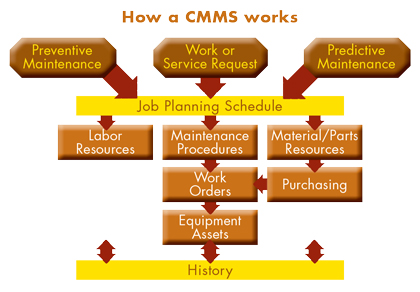Although the majority of enterprise software systems have some form of maintenance module, many are inherently loosely structured and offer only very basic capabilities, mostly for tracking costs. Most of these modules cover maintenance activities, but few offer reliability functions.
So, what is a Computerized Maintenance Management System (CMMS)? Well, in very simple terms it is a database to help manage assets, whether they are rolling stock (fleet) or facilities. An effective CMMS is critical today because information is king and companies with strong abilities to manage information will not only be better positioned to survive these challenging times, but also to prosper.
Lack of proper management of assets can depreciate the value of those assets significantly. The purpose of a CMMS is to aid in the management of assets. It can help improve performance and maintenance department productivity, track and control expenditures, and reduce capital expenditures and operating costs (CAPEX and OPEX), as well as prolong the life of an organization’s assets.
Having had the opportunity to work with numerous software programs over my 42 years in maintenance and engineering, I have seen some excellent programs, some overpriced ones, and many lackluster ones. It’s not like owning a wristwatch, where time is time and the medium (the watch) seems of little concern with respect to the end product (tracking time). A CMMS is much like a race car. Not all automobiles can win a high-speed race, but they all look very similar on a track. In the “race” to reduce costs and run operations more efficiently, some programs are better designed for the track than others.
For the purposes of this article, I would like to focus on the CMMS, which is often a “bolt-on” program that interfaces with the Enterprise Asset Management or Enterprise Resource Planning program an organization would have managing its accounting activities.
There are three approaches that can be used when taking on the task of database management to support equipment: Enterprise Asset Management (EAM), Enterprise Resource Planning (ERP), or a Computerized Maintenance Management System (CMMS). The CMMS, for the focus of this examination, will be considered a separate, standalone program that will interface with the ERP or EAM program.
A good CMMS system needs to provide basic functions to manage maintenance. It must:
- Manage equipment repairs and work orders.
- Manage equipment repair costs.
- Manage PM and PdM.
- Provide the capability to plan for materials, labor, tools, and equipment used in scheduled maintenance.
- Provide the capability to track inventory.
- Create easy-to-follow instructions for mechanics to perform work to be done.
- Provide the capability to record data to track history and costs of maintenance.
- Include reporting for management purposes.
WHAT ARE THE BENEFITS OF USING A CMMS?
- Aids in the detection of impending problems before failure occurs, resulting in fewer failures.
- Results in less unplanned downtime and fewer job delays.
- Improves maintenance information on costs (labor and materials).
- Results in better care, extending equipment life and lowering CAPEX expenditures.
- Provides a tool to aid planning and scheduling, which improves staff productivity.
- Controls inventory more efficiently, allowing better spare parts forecasting.
- Automatically schedules repetitive PM activities based on meter hours, calendar time, or production units (tonnage, cubic yards, etc.).
- Offers means to monitor spares, minimizing shortages and helping to reduce existing inventory.
- Maintains optimal equipment performance and reduces operating costs per hour or per unit.
- Encourages standards and procedures to improve the quality of maintenance activities.
- Converts data into meaningful information through reports for analysis.
- Helps to track all maintenance requests to prevent lost communications.
- Affords a means for tracking backlogs, determining priorities, and scheduling work.
- Compares maintenance expenditures in a given period against previous periods to measure effectiveness of improvement efforts.
- Tracks warranties on equipment to prevent performing covered work.
- Provides a robust process as the the basis for work management and cost control.
- Gives standard task instructions or job plans for repetitive work.
- Allows adjustment of PM by providing a method to monitor failure trends and to examine major causes of equipment breakdowns.
- Provides a means to compare actual task time to estimated task time to improve labor utilization.
- Offers the means to track equipment history.
- Provides the ability to have a centralized repository for maintenance information. ■
In the next issue of MCS, Part Two of this three-part article will deal with how to select the right CMMS program. Part Three will cover implementation pointers and pitfalls to avoid.
About the Author:
Preston Ingalls is president and CEO of TBR Strategies, LLC, a Raleigh, North Carolina-based maintenance and reliability firm specializing in the construction and oil and gas industries. Preston can be reached at pingalls@tbr-strategies.com, or visit www.tbr-strategies.com.
_________________________________________________________________________
Modern Contractor Solutions, January 2014
Did you enjoy this article?
Subscribe to the FREE Digital Edition of Modern Contractor Solutions magazine.



